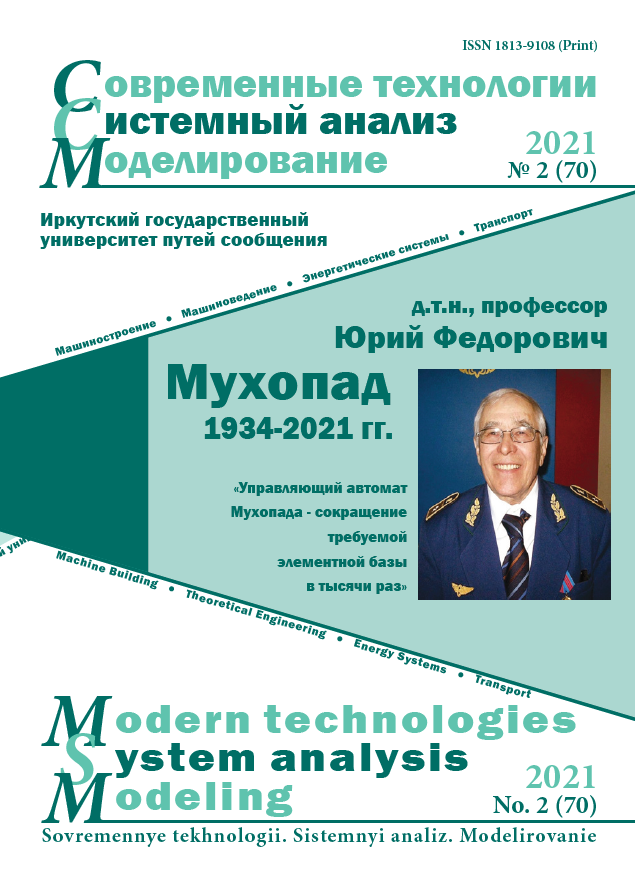Estimation of the freight traffic mobility plan taking into account consignment notes and traffic intensity data
Keywords:
mobility plans, street and road network, traffic flow, modelingAbstract
The article outlines the problem of estimation of freight traffic mobility plan, taking into account the data of consignment notes and traffic intensity. Most of the methods of estimating freight traffic mobility plans are based on comparing the distances between the reconstructed and the original mobility plan, taking into account the flow restrictions. In modern practice of transport modeling, two types of information are most often used when assessing the freight traffic mobility plan. These are the data of consignment notes and the intensity of traffic flows. The mobility plan obtained from the data of consignment notes reflects only the structure of the movement of goods. Due to errors in the information, the mobility plan may differ from the real version of the transportation of goods. The purpose of the study is to estimate the real mobility plan; taking into account the data of consignment notes (as a mobility plan of the movement of goods in the surveyed area) as the original (a priori) mobility plan, as well as the data for calculating the traffic intensity (in accordance with the performance constraints). According to the available information on consignment notes and calculations of the intensity of traffic flows, a variant of assessing the real freight traffic mobility plan is considered using stochastic models and taking into account route selection schemes. Possible errors in information sources − consignment note and traffic intensity data – are analyzed with estimation of each option. To find the optimal mobility plan estimate, a calibrated entropy maximization model with a composite objective function can be used. Thus, using a geographic information system, calibrated distribution models, as well as the entropy function, an estimate of the mobility plan based on the data of consignment notes becomes available.
References
Лебедева О.А., Крипак М.Н. Моделирование грузовых перевозок в транспортной сети // Вестник Ангарского государственного технического университета. 2016. № 10. С. 182–184.
Лебедева О.А., Антонов Д.В. Моделирование грузовых матриц корреспонденций гравитационным и энтропийным методами // Вестник Иркутского государственного технического университета. 2015. № 5 (100). С. 118–122.
Лебедева О.А., Крипак М.Н. Развитие городских грузовых систем с учетом концепции городского планирования: сборник научных трудов Ангарского государственного технического университета. 2016. Т. 1. № 1. С. 244–247.
Федотова А.С., Лебедева О.А. Степень использования пропускной способности автомобильных дорог: сборник научных трудов Ангарского государственного технического университета. 2015. Т. 1. № 1. С. 270–274.
Полтавская Ю.О. Применение геоинформационных систем для обеспечения устойчивого развития транспортной системы города // Информационные технологии в науке, управлении, социальной сфере и медицине: сборник научных трудов VI Международной научной конференции / под ред. О.Г. Берестневой, В.В. Спицына, А.И. Труфанов, Т.А. Глад-ковой. 2019. С. 164–167.
Полтавская Ю.О. Оптимизация транспортной сети на основе минимума общих затрат на доставку грузов // Вестник Ангарского государственного технического университета. 2019. № 13. С. 178–183.
Шаров М.И., Михайлов А.Ю., Дученкова А.В. Пример оценки транспортной доступности с использованием программного продукта PTV «VISUM» // Известия вузов. Инвестиции. Строительство. Недвижимость. 2013. № 1(4). С. 133–138.
Лебедева О.А. Анализ проектирования транспортных зон на основе моделирования сети // Вестник Ангарского государственного технического университета. 2019. № 13. С. 172–177.
Гозбенко В.Е., Крипак М.Н., Иванков А.Н. Совершенствование транспортно-экспедиционного обслуживания грузовладельцев. Иркутск: Изд-во ИрГУПС, 2011. 176 с.
Lebedeva O.A., Kripak M.N., Gozbenko V.E. Increasing effectiveness of the transportation network through by using the automation of a Voronoi diagram. Transportation Research Procedia. 2018. Vol. 36. 427–433.
Afandizadeh S., Yadi S.M. Hamedani Iranian Journal of Science & Technology, 2006. Vol. 30. No. B1.
Abrahamsson T. Estimation of origin-destination matrices using traffic count. international institute for applied systems, Austria. 1998.
Hensher D.A., Button K. J. Handbook of transportation modelling. Pergamon. 2000.
Moore J.E., Kim G. Evaluating system ATMIS technology via rapid estimation of network flows. Final Report, University of Southern California. 1997.
Ortuzar J.D., Willumsen L.G. Modelling transport. Third edition, John Wily & Sons. 2001.
Train K. Discrete choice methods with simulation. Cambrige University Press. 2002.
Kleinbaum D.G., Klein M. Logistic regression. Second edition, Springer. 2002.
Ben-Akiva M., Bierlaire M. Discrete choice methods and their applications to short term travel decisions. Handbook of Transportation Science, Chapter. 1999.
Papacostas C.S., Prevedouro P.D. Transportation engineering and planning. Second edition, Prentice-Hall. 2001.
Philips D.T., Garcia-Diaz A. Fundamentals of network analysis, Prentice-Hall. 1981.
Кузьмин О.В., Старков Б.А. Бинарные матрицы с арифметикой треугольника паскаля и символьные последова-тельности. Известия Иркутского государственного университета. Серия: Математика. 2016. Т. 18. С. 38-47.
Кузьмин О.В. построение обобщенных A- и В-полиномов в пространстве отображений. В сборнике: Методы дискретного анализа в теории графов и сложности. Новосибирск, 1992. С. 66-76.
Кузьмин О.В., Леонова О.В. Полиномы Тушара и их приложения. Дискретная математика. 2000. Т. 12. № 3. С. 60-71.
Burrell J.E. Multiple route assignment: a comparison of two methods. International Symposium of Traffic Equilibrium Methods, Montreal. 1974.
Dial R.B. A probabilistic multipath assignment model which obviates path enumeration. Transportation Research 9. 1975. Pp. 123–128.
Maher M. SAM – a stochastic assignment model, mathematics in transportation planning and control. Oxford University Press, 1991. Pp. 121–132.
Brenninger-Gothe M., Jurnsten K.O. Estimation of origin-destination matrices from traffic count using multi-objective programming formulation. Transportation Research. Part. B, 23B(4). 1989. Pp. 257–269.
Krishnan V., Hancock K.L. Highway freight flow assignment in Massachusetts using geographic information system. Transportation Research Record, 1998. No. 1625.


